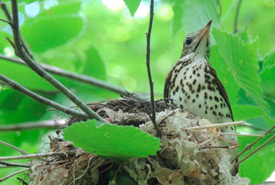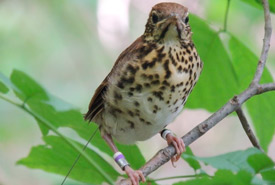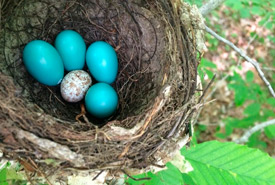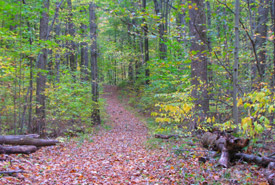Tracking wood thrush through Ontario forests

Adult wood thrush at her nest (Photo by Sue Hayes)
Each year, the wood thrush travels thousands of kilometres from its over-wintering habitat in the tropical regions of Central America to its breeding habitat in forests throughout southern Ontario.
This medium-sized songbird, like many other migratory bird species, is facing significant population declines because of habitat loss.

A juvenile wood thrush wearing a radio-tag backpack on an NCC property (Photo by Sue Hayes)
A fellow York University graduate student, Brendan Boyd, and I are conducting research to determine if juvenile wood thrush born and raised in small forest patches have less chance of survival than those raised in larger-sized forests. For our study, we selected 20 forest fragments throughout southern Ontario’s Norfolk County, including properties protected by the Nature Conservancy of Canada (NCC), such as Backus Woods.
Research has shown that songbird nests in smaller forests have a greater chance of predation and falling victim to brown-headed cowbirds.
Originally from the prairies, but now common in southern Ontario, brown-headed cowbirds are parasitic birds that wait until the adult songbird lays its eggs and leaves the nest. The cowbird then sneaks in and lays its own egg, leaving the unsuspecting songbird to incubate and feed the nestling cowbird, usually at the expense of its own young. Cowbirds often hatch first, grow faster and become very vocal in demanding food. This leaves the songbird parents exhausted and with fewer resources for their own young.

Wood thrush eggs (blue) with one brown-headed cowbird egg (Photo by Sue Hayes)
Last field season, starting in mid-May, Brendan and I searched for wood thrush nests throughout our study sites. We counted the number of wood thrush nests that were used by cowbirds, along with the number that were predated by eastern chipmunks, squirrels, blue jays, American crows, grackles, a variety of hawk species and snakes.
Through our research, we are also tracking the movements of young birds once they are no longer dependent on their parents for food. Conventional radio tags, which are typically used, can only be detected one to two kilometres away from a manual receiver. The new Motus Wildlife Tracking System uses a network of automated receivers to track birds over long distances. This tracking system was developed through Bird Studies Canada in partnership with Acadia University, and now has hundreds of researchers collaborating through the use of its more than 300 towers.
A Motus Wildlife Tracking tower (Photo by Sue Hayes)
Once the nestlings are 10 days old, we fit them with tiny radio-tag backpacks, which can then be detected by the Motus towers for up to a year. The radio tag sends out a signal detected by a tower if the bird flies within five to 10 kilometres of it. We are then able to piece together where the birds are going after leaving their parents and whether they return to Ontario to breed the following season.
Last summer, Brendan and I also tagged adult wood thrushes to learn more about their movements once they leave Norfolk County and begin their long, southward migration to the tropics for the winter.
So far, we have completed one of three field seasons of data collection. We are excited for the return of the birds this spring to collect more information that will help us try and understand the difficulties facing this species of special concern on their breeding grounds.


